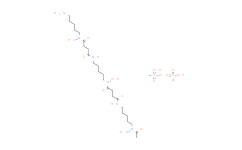| 中文名称: | 去铁胺甲磺酸盐 促销 | ||||
|---|---|---|---|---|---|
| 英文名称: | Deferoxamine mesylate salt | ||||
| 别名: | 去铁胺 DFOM | ||||
| CAS No: | 138-14-7 | 分子式: | C25H48N6O8.CH4O3S | 分子量: | 656.79 |
| CAS No: | 138-14-7 | ||||
| 分子式: | C25H48N6O8.CH4O3S | ||||
| 分子量: | 656.79 | ||||
| MDL: | MFCD00058605 | EINEC: | 205-314-3 | ||
| EINEC: | 205-314-3 | ||||
基本信息
|
产品编号: |
D10566 |
||||
|
产品名称: |
Deferoxamine mesylate salt |
||||
|
CAS: |
138-14-7 |
储存条件 |
粉末 |
-20℃ |
四年 |
|
|
|
||||
|
分子式: |
溶于液体 |
-80℃ |
两年 |
||
|
分子量 |
656.79 |
-20℃ |
一个月 |
||
|
化学名: |
|||||
|
Solubility (25°C): |
|||||
|
体外:
|
DMSO |
100mg/mL (152.25mM) |
|||
|
Ethanol |
Insoluble |
||||
|
Water |
100mg/mL (152.25mM) |
||||
|
体内(现配现用): |
1.请依序添加每种溶剂:PBS Solubility: 5.56mg/mL (8.47mM); Clear solution; Need ultrasonic |
||||
|
<1mg/ml表示微溶或不溶。 |
|||||
|
普西唐提供的所有化合物浓度为内部测试所得,实际溶液度可能与公布值有所偏差,属于正常的批间细微差异现象。 |
|||||
|
请根据产品在不同溶剂中的溶解度选择合适的溶剂配制储备液;⼀旦配成溶液,请分装保存,避免反复冻融造成的产品失效。 |
|||||
制备储备液
|
浓度
溶液体积 质量 |
1mg |
5mg |
10mg |
|
1mM |
1.5226mL |
7.6128mL |
15.2256mL |
|
5mM |
0.3045mL |
1.5226mL |
3.0451mL |
|
10mM |
0.1523mL |
0.7613mL |
1.5226mL |
|
50mM |
0.0305mL |
0.1523mL |
0.3045mL |
生物活性
|
产品描述 |
一种铁螯合剂,常用于研究细胞增殖和凋亡。用作一个缺氧模拟物质去稳定低氧诱导因子1 (HIF-1)。 去铁胺通过抑制以HIF-1为靶点的脯氨酰羟化酶(PHDs)降解来稳定HIF-1。 去铁胺的抑制机制可能是通过Fe2+ 与酶活性所需的PHD活性位点的螯合作用而实现的。 |
||
|
靶点 |
HIF-1α |
Beta Amyloid |
Ferroptosis |
|
体外研究 |
Deferoxamine treatment significantly increases HIF-1α binding under all culture conditions, including hypoxic and high glucose. The mechanism of deferoxamine is through improving HIF-1α biological function through scavenging oxygen free radicals. Deferoxamine (5μM) has significant effect on the tumor-associated stromal cells cellular multiplication, and cells die at day 7 after exposure to 50μM and 100μM deferoxamine. Deferoxamine (5μM-100μM) inhibits the proliferation of BMMSCs, and induces apoptosis of MSCs in a dose-dependent manner. Deferoxamine influences the expression of adhesion proteins on MSCs. Deferoxamine (30, 60, 120μM) shows lower expression of HIF-1α in a concentration dependent way in AdMSCs |
||
|
体内研究 |
Deferoxamine (100mg/kg, i.p.) lowers the mortality rate of subarachnoid hemorrhage (SAH) rat. Deferoxamine (100mg/kg, i.p.) attenuates Evan’s blue extravasation in cortex, ameliorates the tight junction detachment and preserves the integrity of the base membrane examined in electron microscope at day 3 after SAH. Deferoxamine attenuates degradation of BBB proteins after SAH and significantly reduces ferritin expression at day 3 in the cortex, and improves neurologic behavior and cognitive deficits after experimental. Ten µL of 1mM deferoxamine-treated wounds display significantly accelerated healing from day 7 onward and heal significantly faster than control-treated wounds in diabetic mice. Deferoxamine-treated wounds and dimethyloxalylglycine-treated wounds heal significantly faster than control-treated wounds in aged mice. In deferoxamine (10mg/mL)-treated TG mice, there is a decrease in both soluble and insoluble Aβ40 and Aβ42. Both pGSK3β and β-catenin are significantly increased by approximately 50% in the deferoxamine-treated mice |
||
推荐实验方法(仅供参考)
|
Cell Assay |
Harvested murine tumor and bone marrow-derived MSCs are exposed to varying doses of deferoxamine. Cell viability is assessed by trypan blue exclusion assay. The viable cells are more than 98% before enrolled for experiments. A total of 1.5×105 TAMSCs/well or 3×105 BMMSCs/well are seeded in 6-well plates. Then MSCs are exposed to 5, 10, 25, 50, and 100μM deferoxamine on the following day. After 7 days, the number of TAMSCs is counted. To assess the cytotoxicity of deferoxamine to primary bone marrow MSCs, 2×106 bone marrow cells/well are seeded in 24-well plates. After 9 days, the number of survival cells is counted. To assess the cell cycle, TAMSCs are stained with propidium iodide, and cell cycle distribution is analyzed by flow cytometry. |
|
|
|
|
Animal Administration |
Mice are divided into three treatment groups of 17 each: (1) TG mice given IN Deferoxamine (TG-DFO), (2) TG mice given IN phosphate buffered saline (TG-PBS), and (3) WT mice given IN PBS (WT-PBS). At 30 weeks of age, mice are acclimated to handling and then treated intranasally every monday, wednesday, and friday, starting at 36 weeks of age. Mice are dosed for 18 weeks, until behavior tests at 54 weeks. Dosing continues during the 4 weeks of behavior to measure both chronic and acute effects. After behavior mice are dosed a final time, and 24 h later euthanized and tissues collected for biochemical analyses. These include soluble and insoluble amyloid as measured by ELISA and IHC, quantification of proteins with Western blot and oxidative markers |
本计算器可帮助您计算出特定溶液中溶质的质量、溶液浓度和体积之间的关系,公式为:
质量 (g) = 浓度 (mol/L) x 体积 (L) x 分子量 (g/mol)
摩尔浓度计算公式
用本工具协助配置特定浓度的溶液,使用的计算公式为:
开始浓度 x 开始体积 = 最终浓度 x 最终体积
稀释公式
稀释公式一般简略地表示为:C1V1 = C2V2 ( 输入 输出 )








